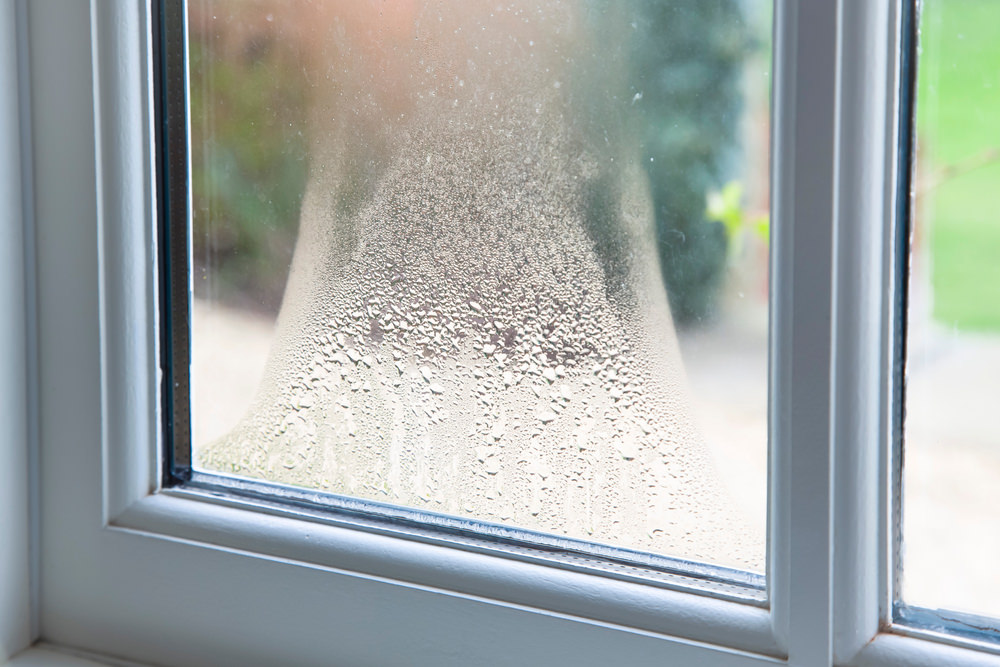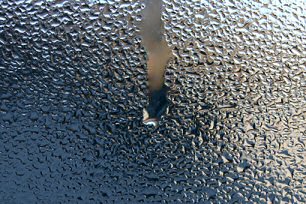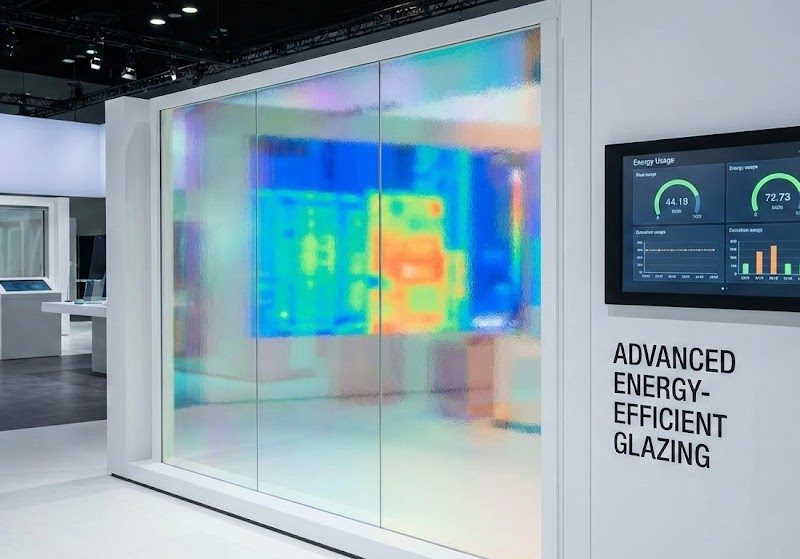
Timber - PVC - Aluminium - Windows, Doors & Conservatories in Hampshire
The Ultimate Guide to Double Glazing Condensation: Inside, Outside & Between the Panes
The Ultimate Guide to Double Glazing Condensation: Inside, Outside & Between the Panes
Estimated reading time: 12 minutes
Condensation on windows is a common sight across properties especially during the colder months. Seeing water build-up can be worrying, but it is critical to understand that not all condensation is a sign of a fault.
Condensation occurs when moist air comes into contact with a surface that is cooler than the air’s “dew point.” Your double glazing is the perfect surface for this to happen.
This comprehensive guide from KJM Group will help you diagnose the three distinct types of double glazing condensation, explain the cause, and tell you exactly how to fix the problem—whether the solution is simple DIY ventilation or calling our professionals for a glass replacement.
Where is your condensation?
Type 1: Water on the INSIDE of the Window
This is the most common issue. It is caused by high moisture and humidity inside your home (from cooking, showering, etc.) hitting the cool surface of the glass.
This is NOT a fault with the window. It is a sign that you need to increase ventilation to reduce the humidity in your home.
Type 2: Water on the OUTSIDE of the Window
This is a GOOD sign, usually seen on new, high-efficiency windows (like triple glazing). It means your window is so well-insulated that the outer pane of glass gets cold enough for dew to form.
This is not a fault and requires no action. It is proof your windows are working perfectly to keep heat inside your home.
Type 3: Water BETWEEN the Panes of Glass
If you see misting, fogging, or water droplets *inside* the sealed unit (where you cannot touch it), this IS a product fault.
This means the perimeter seal has failed and the glass unit needs to be replaced. This is covered by your KJM warranty.
Table of contents

KEY TAKEAWAYS: Condensation Guide Summary
- 1. Condensation is Not Always Bad: Moisture on the exterior glass is natural and indicates your windows are working perfectly, preventing heat loss.
- 2. Internal Moisture is a Ventilation Issue: Condensation on the interior glass is caused by high humidity in your home. The simple fix is increasing ventilation (e.g., using trickle vents and extractor fans).
- 3. Misting Between the Panes is a Defect: Moisture trapped between the panes means the perimeter seal has failed. This requires immediate replacement of the glass unit to restore energy efficiency.
- 4. Local Repair Experts: KJM Group provides fast, professional replacement of all failed sealed units across Andover, Winchester, Amesbury, and the wider Hampshire/Wiltshire area.
1. Condensation on the Outside Pane (The Good News)
What is it?
This is moisture that forms on the outside surface of your exterior glass pane.
The Cause (The Good News)
External condensation is a positive indicator that your double-glazed unit is working exactly as it should. Modern, high-performance units (especially those with Low-E coatings) are exceptionally efficient at preventing heat from your home from escaping through the glass.
Because very little heat is escaping, the outer pane of glass remains cold, often dropping below the exterior dew point overnight. The moist outside air condenses onto the cold glass surface.
The Fix
No action is required. This is a temporary, natural occurrence that will evaporate as the morning sun warms the glass. If you see this, you can be confident your windows are highly energy efficient!
2. Internal Condensation: The Ventilation Challenge
What is it?
This is moisture that forms on the inside surface of your interior glass pane. This is the most common and easily fixable type of condensation.
The Cause (High Humidity)
Internal condensation is almost always a sign of high humidity and poor ventilation within your home, which is typical during winter when windows are kept closed. Everyday activities generate significant moisture:
- Cooking (especially without an extractor fan)
- Showering/Bathing
- Drying laundry indoors
- Even breathing (a family of four can produce several pints of moisture daily)
When this moisture-laden air hits the coldest surface in the room (the glass), it releases as water droplets
The Hidden Danger: Condensation, Black Mould, and Your Health
Beyond being a simple annoyance, persistent internal condensation is a serious warning sign. The moisture it creates on walls, window frames, and seals is the primary ingredient needed for mould growth, including black mould (Stachybotrys chartarum).
This isn’t just a cosmetic problem; it’s a health risk.
According to the NHS, mould produces allergens, irritants, and sometimes toxic substances. Inhaling or touching these mould spores can trigger a range of health issues, particularly for the elderly, infants, and people with:
- Asthma or other respiratory conditions
- Allergies
- A weakened immune system
Common health problems linked to mould include:
- Respiratory Issues: Wheezing, coughing, and shortness of breath.
- Asthma Attacks: Mould can be a significant trigger for those with asthma.
- Allergic Reactions: Sneezing, a runny nose, red eyes, and skin rashes.
- Nasal Congestion: A persistent stuffy nose.
By tackling the root cause of internal condensation, you are not just protecting your windows; you are actively protecting the health and air quality of your home.
How to Safely Clean Existing Mould
If you already see mould, it’s important to remove it safely. Always prioritise safety: wear rubber gloves, safety goggles, and a mask that covers your nose and mouth to avoid inhaling the spores.
- Step 1: Create a solution using one part bleach to four parts water, or use a 50/50 solution of white vinegar and water.
- Step 2: Apply the solution with a cloth or spray bottle directly onto the mouldy area.
- Step 3: Let it sit for 15-20 minutes. Do not scrub dry mould, as this will release spores into the air.
- Step 4: Wipe the area clean with a damp cloth, then dry it thoroughly with a clean, dry cloth.
- Step 5: Dispose of the cloths and gloves immediately.
Note:- Both distilled white vinegar and hydrogen peroxide will do an effective job of killing mold spores in porous materials. Bleach can only kill mold on non-porous surfaces, as it does not penetrate porous surfaces; so mould roots are left to grow again.
The Cure (Actionable DIY Solutions for Your Home)
You can drastically reduce interior condensation and improve your indoor air quality by effectively managing air movement and moisture generation.
For homes with persistent, high humidity despite ventilation efforts, a domestic dehumidifier can be an effective solution to actively extract excess moisture from the air.
How to Introduce Consistent Ventilation
- Utilise Trickle Vents: If your uPVC or aluminium windows have trickle vents (the small slots at the top of the frame), ensure they are open constantly, even in winter. These are designed to allow a small, continuous exchange of air, helping to remove moist air without significant heat loss.
- Open Windows Regularly: Aim to open windows for 5-10 minutes daily, especially in rooms prone to moisture (bedrooms, living areas), to cycle out stale, moist air. Even a small crack makes a difference.
- Install Extractor Fans: Ensure extractor fans in kitchens and bathrooms are fully functional and always used when cooking or showering. Leave them running for at least 15-20 minutes after you finish to remove lingering humidity. Consider installing humidistat-controlled fans for automatic operation.
- Avoid Blocking Vents: Ensure no furniture or curtains are blocking existing air vents or trickle vents, which impedes crucial airflow.
Actively Reduce Moisture Sources
- Relocate Laundry Drying: If possible, avoid drying laundry indoors, especially on radiators, as this releases a vast amount of moisture directly into your home. If necessary, place laundry in a designated room with a window slightly ajar and the door closed, or use a vented tumble dryer.
- Cover Cooking Pots: Always use lids on pots and pans when cooking to contain steam.
- Contain Shower Steam: Close bathroom doors when showering to prevent steam from spreading to other parts of the house.
- Check for Leaks: Periodically inspect plumbing, roofs, and walls for any hidden leaks or damp patches that could be contributing to indoor humidity.
Manage Heating Effectively
- Maintain Consistent Temperatures: Avoid large temperature fluctuations. Maintaining a consistent, moderate temperature throughout your home (rather than letting it cool completely overnight) helps because warmer air can hold more moisture before it condenses.
- Heat Unused Rooms: Try to heat all rooms, even those rarely used, to a lower background temperature. Cold, unheated rooms are prime spots for condensation and eventually mould.
Consider Dehumidifiers:
- For homes with persistent, high humidity despite ventilation efforts, a domestic dehumidifier can be an effective solution to actively extract excess moisture from the air.
3. Condensation Between the Panes (The Seal Failure)
What is it?
This is moisture, fogging, or mineral deposits that appear trapped between the two sheets of glass inside your sealed unit. This is sometimes called a “misted unit.”
The Cause (Loss of Energy Efficiency)
Condensation between the panes is the definitive sign of a failed sealed unit:
- Seal Breakdown: The perimeter seal around the glass (usually at the spacer bar) has cracked or degraded due to age or movement.
- Gas Escape: The inert, non-toxic gas (like Argon) that provides the unit’s thermal insulation has escaped.
- Moisture Ingress: External moisture-laden air has entered the cavity, resulting in fogging or permanent mineral stains.
The Consequence
This is not a cosmetic issue—it is a performance defect:
- Loss of WER: The window loses its Window Energy Rating (WER) and is no longer thermally efficient.
- Increased Bills: The failed unit allows heat to escape far more easily, increasing your energy consumption in your Hampshire home.
- Aesthetics: The permanent fogging obscures your view and lowers your property’s appeal.
The Fix: Replacement is Essential
While some companies offer “de-misting” services, KJM Group strongly advises against them. They involve drilling a hole to remove the moisture, but they cannot restore the Argon gas or the unit’s lost thermal efficiency.
The only effective, long-term fix is replacement of the insulated glazed unit (IGU). We simply remove the failed glass and install a brand-new, gas-filled, high-performance unit into your existing uPVC, timber, or aluminium frame, instantly restoring its original efficiency.
Misted Glass? Get a Free Quote to Restore Your Efficiency
Don’t pay high heating bills for a failed unit. We provide swift, professional glass replacement for all frame types in Andover and across our 30-mile service area.
📧 GET MY GLASS REPLACEMENT QUOTE4. KJM Group’s Professional Condensation Solutions
If you are dealing with persistent internal condensation, our team can check that your trickle vents are functioning and that your hinges and seals are compressing properly. However, if you have moisture between the panes, you need our replacement service.
KJM Group operates across Andover, Winchester, Amesbury, Whitchurch, and the surrounding 30-mile radius in Hampshire, Berkshire and Wiltshire. We focus on providing cost-effective solutions by replacing only the failed components.
Our service includes:
- Diagnosis: Pinpointing the exact cause of moisture issues (ventilation vs. seal failure).
- Sealed Unit Replacement: Professional removal of failed units and installation of new, high-performance, gas-filled glass.
- Hinge & Seal Check: Ensuring the mechanical components of your window are fully functional to prevent premature seal failure.
Don’t let a failed sealed unit compromise your home’s comfort and energy efficiency.
Further advice in the GGF Condensation guide
Contact KJM Group today for an Expert Assessment
📞Call 01264 359355
📧 Email [email protected]
Visit Our Andover Showroom & Get DirectionsFrequently Asked Questions (FAQs)
Yes, absolutely. Condensation on the outer pane of glass is a good sign. It means your double or triple glazing is working perfectly, keeping heat inside your home so the outer pane stays cold enough for dew to form (just like on grass).
Your old, draughty windows had gaps that allowed a constant, uncontrolled flow of air, which removed the moisture (along with all your heat!). Your new, energy-efficient windows have airtight seals. This stops the draughts but also traps the moisture your home produces. This is not a fault; it just means you now need to manage your home’s ventilation using trickle vents and extractor fans to let the moisture out in a controlled way.
It’s simple: can you wipe it away? If the moisture is on the inside surface of the glass (in your room), it’s a ventilation issue. If the moisture is trapped BETWEEN the two panes of glass, the seal has failed, and the unit needs to be replaced.
This depends on the type. Condensation on the INSIDE (Type 1) or OUTSIDE (Type 2) of the glass is a natural environmental or ventilation issue and is not a fault. Condensation BETWEEN the panes (Type 3) is a seal failure and is covered under your KJM warranty for the specified period.
We do not recommend it. Some companies offer “de-misting” by drilling a hole, but this does not restore the insulating Argon gas that was lost. The only way to restore your window’s full thermal efficiency is to replace the entire sealed glass unit.
Trickle vents are essential for providing background ventilation and will make a big difference. However, they are not designed to handle high-moisture events like cooking, showering, or drying laundry. You must also use high-power extractor fans for these activities to remove the moisture at the source.
Recommended
⭐ Real Reviews, Real Peace of Mind
Our reputation is built on over 700 independent reviews.
- Which? Trusted Traders: 4.9/5 (100% of customers recommend us)
- Google: 4.9/5 (from 250+ reviews)
- Checkatrade: 9.87/10 (from 360+ reviews)
“As a Commercial Construction Project Manager I cannot recommend highly enough the service and window installation that KJM carried out on my home… their communication and service was exemplary.” – KJM Customer Review
We are also a long-standing member of the Glass and Glazing Federation (GGF) and are Trading Standards Approved, so you are fully protected.
- The 2026 Glazing Outlook” – High-level summary of the pivot to growth. - 9 December 2025
- Industry News: The Future Homes Standard 2025 & What It Means for Your Windows - 1 December 2025
- KJM Group MD Attends House of Commons Event to Champion UK Glass Industry - 14 November 2025













